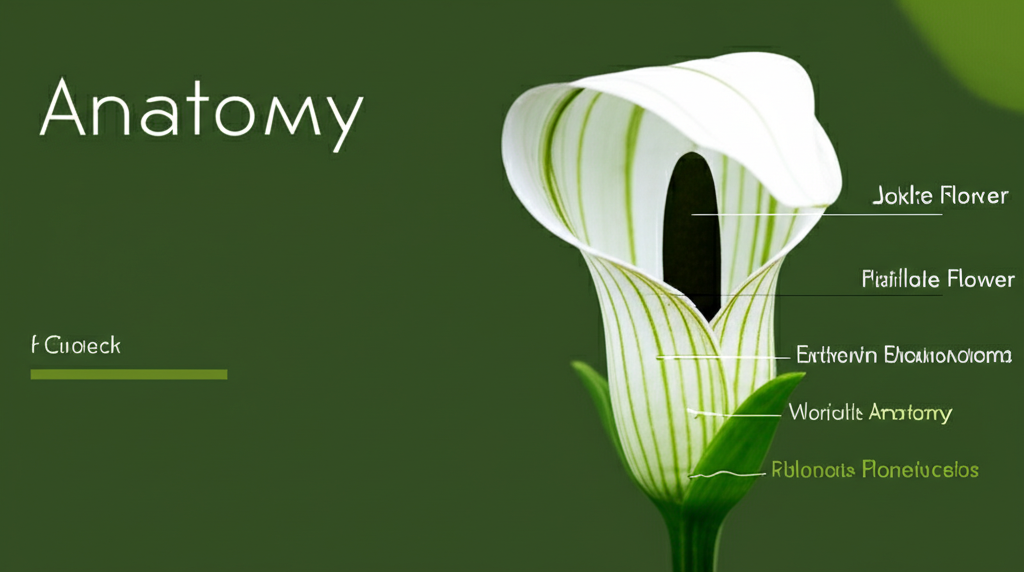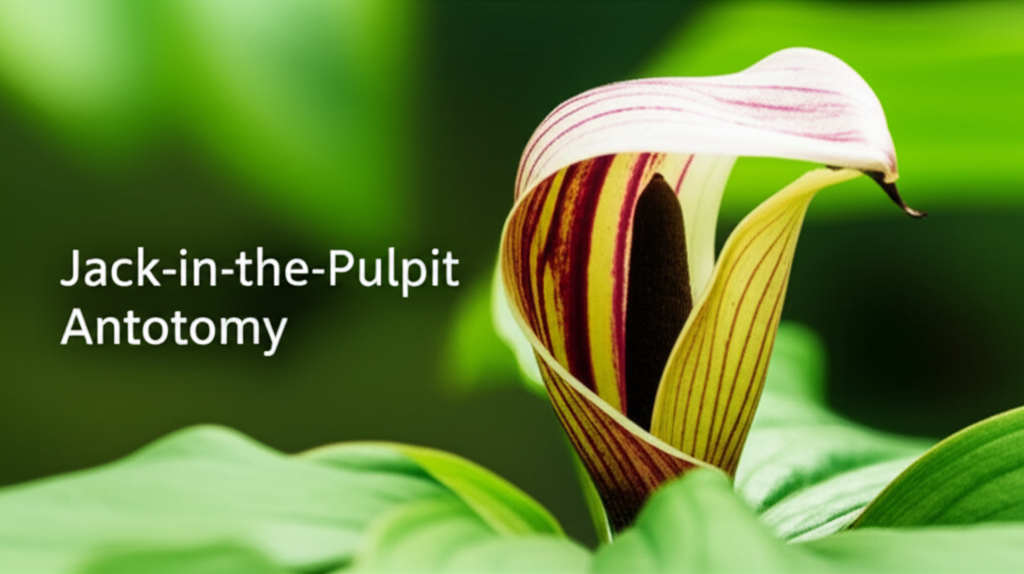The Mystique of the Jack-in-the-Pulpit: A Botanical Marvel
The Jack-in-the-Pulpit, scientifically known as Arisaema triphyllum, is a captivating woodland perennial that often sparks curiosity with its unusual and highly specialized flower structure. Native to eastern North America, this plant is more than just a woodland beauty; it’s a masterclass in botanical adaptation, particularly in its intricate floral anatomy and remarkably clever pollination strategy. Its common name, derived from the resemblance of its spathe to a pulpit and its spadix to a preacher, hints at the unique spectacle it presents. Understanding the inner workings of this fascinating plant reveals a sophisticated interplay between structure, function, and the vital act of reproduction.
Deconstructing the Jack-in-the-Pulpit: A Detailed Anatomical Breakdown

To truly appreciate the Jack-in-the-Pulpit’s pollination techniques, a thorough understanding of its floral anatomy is essential. What appears to be a single, hooded flower is, in fact, a complex inflorescence, a cluster of small, true flowers enclosed within a distinctive sheath.
The Spathe: The Pulpit’s Canopy
The most conspicuous part of the Jack-in-the-Pulpit is the spathe, a large, leaf-like bract that encloses the reproductive structures. This spathe typically arches over the spadix, forming a hooded or helmet-like structure. It can vary in color from green to deep purple-brown, often exhibiting stripes or mottling. The primary function of the spathe is to protect the delicate reproductive organs and to guide pollinators into the trap. Its unique shape and often alluring colors play a crucial role in attracting its intended visitors.
The Spadix: The Preacher’s Lectern
Emerging from the base of the spathe is the spadix, a fleshy, club-shaped or cylindrical spike that bears the true flowers. The spadix is the “Jack” in the pulpit. Its upper portion is sterile and tapers to a point, sometimes extending beyond the spathe, while its lower portion is densely packed with numerous tiny, unisexual flowers. In many species, the lower part of the spadix is covered in downward-pointing, hair-like structures called staminodes. These staminodes are not fertile and serve a critical purpose in the pollination mechanism.
The True Flowers: Hidden Wonders
The actual flowers of the Jack-in-the-Pulpit are diminutive and clustered tightly along the lower part of the spadix. They are unisexual, meaning individual flowers are either male or female. Typically, the female flowers are located at the base of the spadix, closest to the corm (the underground storage organ), and are followed by the male flowers higher up. This arrangement is a common adaptation in plants to ensure efficient pollination. The female flowers have a pistil, which develops into a berry after successful pollination. The male flowers have stamens that produce pollen.
The Spadix Appendage and Staminodes: The Sticky Trap Mechanism
The sterile tip of the spadix, and importantly, the staminodes that often cover the fertile flowers, are key to the plant’s pollination strategy. The staminodes are crucial. They are stiff, bristle-like structures that angle downwards, preventing insects from easily escaping once they have entered the spathe. Some researchers suggest that the spadix itself, or parts of it, may exude a mild perfume or even heat, further attracting insects. The downward-pointing hairs create a “one-way trap,” allowing insects to enter but making it difficult for them to climb back out.
The Corm: The Root of Sustenance
While not directly part of the flower anatomy, the corm is vital for the plant’s survival and reproductive cycle. This swollen underground stem stores energy and nutrients, enabling the plant to produce its distinctive flower and foliage year after year. The corm also contains calcium oxalate crystals, making the plant irritating if eaten by humans or most animals, a defense mechanism that further protects its reproductive efforts.
A Symphony of Attraction and Deception: The Pollination Process
The Jack-in-the-Pulpit employs a sophisticated and somewhat devious method to ensure its pollen reaches receptive stigmas. It’s a classic example of “trapping pollination,” where small insects are lured into the spathe and then prevented from leaving until they have performed their pollinating duty.
Attracting the Unwary: The Lure
The primary attractants for pollinators are the spathe’s visual cues and potential olfactory signals. The coloration, often rich and striking, serves as a beacon in the dim forest understory. While the scent is not universally strong, it’s believed that some insects are drawn by a subtle fragrance. The structure of the spathe itself, creating a sheltered, inviting space, also plays a role.
The Deceptive Trap: Enter the Fly
The most common pollinators are small flies, particularly fungus gnats and midges. These insects are attracted to the spathe, likely seeking shelter, a potential food source, or a place to lay eggs. Upon entering the spathe, they find themselves in a dark, enclosed chamber.
The Downward Spiral: The Staminode Struggle
Once inside, the unsuspecting fly encounters the staminodes. These downward-pointing hairs, like a slippery slope, make upward movement extremely difficult. The insect struggles to escape, crawling up and down the spadix. In its frantic efforts to exit, it brushes against the fertile flowers. If the insect has visited another Jack-in-the-Pulpit recently, it will carry pollen from that plant. As it moves amongst the flowers on the spadix, this foreign pollen can be deposited onto the stigmas of the female flowers.
The Release: A Calculated Escape
After a period of confinement (which can last for several days), the staminodes on the spadix may wither or soften, or the insect may find a way to maneuver past them. Crucially, the male flowers, located higher up on the spadix, are usually mature and shedding pollen by the time the insect is able to escape. As the insect finally makes its way out of the spathe, it will inevitably brush against these male flowers, collecting fresh pollen on its body. This pollen will then be carried to another Jack-in-the-Pulpit, continuing the cycle.
The Role of Heat and Humidity
Some research suggests that the spadix may generate a slight amount of heat and increase humidity within the spathe. This could mimic the conditions found in decaying organic matter, a common breeding ground for flies, further enhancing the plant’s deceptive appeal.
Key Facts and Comparative Anatomy
The Jack-in-the-Pulpit is a member of the Araceae family, a diverse group of flowering plants known for their often striking spathe and spadix inflorescences. While many aroids share this general structure, Arisaema triphyllum has a particularly well-defined and effective pollination mechanism.
| Scientific Name | Arisaema triphyllum |
| Family | Araceae (Arum family) |
| Habitat | Moist, shaded woodlands, stream banks |
| Reproductive Structure | Spike (spadix) enclosed by a spathe |
| Pollinators | Primarily small flies (fungus gnats, midges) |
| Pollination Mechanism | Trapping pollination |
| Key Features | Hooded spathe, spadix with staminodes (downward-pointing hairs) |
| Fruit | Red or greenish berries |
| Feature | Jack-in-the-Pulpit (Arisaema triphyllum) | Peace Lily (Spathiphyllum spp.) | Calla Lily (Zantedeschia aethiopica) |
|---|---|---|---|
| Spathe | Hooded, often green to purplish-brown, forms a trap | Large, pure white, typically held upright, less of a trap | Conical or bell-shaped, pure white, elegant |
| Spadix | Club-shaped, covered in staminodes, central to trapping | Long and slender, often yellowish, exposed | Thick and cylindrical, yellowish, exposed |
| Pollination Strategy | Trapping mechanism with staminodes to retain pollinators | Attracts pollinators with visual appeal and scent; less reliance on trapping | Relies on visual attraction and scent; pollinators access flowers directly |
| Pollinators | Small flies, beetles | Beetles, bees, flies | Flies, beetles |
Mastering the Art of Reproduction: Steps and Outcomes
The life cycle and pollination of the Jack-in-the-Pulpit are a testament to evolutionary ingenuity. The process unfolds in distinct stages, each contributing to the plant’s reproductive success.
| Step | Description | Pros | Cons |
|---|---|---|---|
| 1. Spathe Development and Attraction | The spathe unfurls, displaying its color and form to attract pollinators. | Effective visual lure in shaded environments. | Can be damaged by weather or herbivores before pollination. |
| 2. Insect Entry and Trapping | Small insects, attracted by scent or shelter, enter the spathe. Downward-pointing staminodes prevent easy escape. | Ensures pollinators are in close contact with flowers. High success rate for trapping, increasing pollen transfer likelihood. | Relies on specific insect behavior; if no suitable insects are present, pollination fails. |
| 3. Pollen Transfer (Pollen Deposition) | While trapped, insects brush against female flowers, depositing pollen from previous visits. | Facilitates cross-pollination from other plants. | Ineffective if the insect is a virgin visitor and has no pollen. |
| 4. Pollen Collection | As the insect attempts to escape, it collects pollen from the mature male flowers on the upper spadix. | Ensures the plant has pollen to carry to other individuals. | The insect might escape before collecting sufficient pollen if the staminodes are not effective enough. |
| 5. Successful Fertilization and Fruit Development | If pollination is successful, the ovules in the female flowers develop into bright red berries. | Provides a food source for birds, which aid in seed dispersal. | Pollination success is not guaranteed; the plant may produce no fruit in a given year. |
| 6. Seed Dispersal | Birds consume the berries and excrete the seeds elsewhere, aiding in the plant’s propagation. | Efficient method for spreading seeds over a wider area. | Seed viability can be affected by passage through the digestive tract. |
Ecological Significance and Conservation
The Jack-in-the-Pulpit’s specialized pollination strategy highlights the intricate relationships within forest ecosystems. Its reliance on specific pollinators means that changes in insect populations can directly impact the plant’s reproductive success. Habitat fragmentation and the loss of native plant communities pose threats to this unique species.
Conservation efforts often focus on protecting woodland habitats and maintaining biodiversity, which in turn supports the complex web of interactions, including pollination, that these plants depend on. Understanding the detailed anatomy and pollination techniques of the Jack-in-the-Pulpit not only deepens our appreciation for its botanical marvel but also underscores the importance of preserving the delicate balance of our natural world.
Conclusion: A Masterpiece of Nature’s Engineering
The Jack-in-the-Pulpit is far more than just a curiously named wildflower. Its floral anatomy, from the protective spathe to the trapping spadix adorned with staminodes, is a testament to millions of years of evolutionary refinement. The ingenious pollination technique, a calculated deception that lures small flies into a temporary prison, ensures the transfer of pollen and the continuation of the species. This remarkable plant serves as a vivid reminder of the incredible diversity and complexity of life, a true masterpiece of nature’s engineering.


